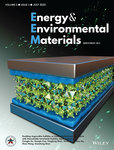投稿信息
稿件收录要求
Energy & Environmental Materials (EEM) is an international journal published by Zhengzhou University in collaboration with John Wiley & Sons, Inc. for the publication of high quality, agenda-setting research related to materials for energy harvesting, conversion, storage, and transport as well as cleaner environment. EEM publishes research work of significant general interest with high impact on society-relevant technological advances.
The journal scope is intentionally broad and the journal recognizes the complexity of issues and challenges related to energy and environmental materials, and therefore, particularly welcomes experimental and theoretical work of interdisciplinary nature across basic science and engineering disciplines. The areas include but are not limited to materials and composites for:
• Photovoltaics & photoelectrochemistry
• Thermoelectricity, piezoelectricity, and triboelectricity
• Batteries, fuel cells, and supercapacitors
• Bioprocessing
• Environmental remediation
• Clean air
• Carbon capture, storage, and utilization
• Clean water, waste water treatment, and desalination
• Devices with multifunctionality
Readership
Chemical, physical, biological, materials, and environmental scientists and engineers spanning a wide readership across academia, industry, and policy-making.
Keywords
materials science, energy materials, environmental materials, nanomaterials, nanocomposites, nanotechnology, biomaterials, two-dimensional materials, porous materials, dielectrics, metamaterials, self-assembly, hierarchical materials, heterostructures, MOFs, COFs, nanotubes, nanowires, nanoparticles, carbon materials, semiconductors, superconductors, ionic conductors, mixed conductors, electrodes, electrolytes, membranes, separators, surface and interface, in situ and in-operando characterization, electrochemistry, charge transfer, defects, metals and alloys, ceramics, organics, polymers, thin films, colloids, optics, sensors, light emitting materials, photovoltaics, solar cells, photonics, batteries, fuel cells, supercapacitors, thermoelectrics, air pollution control, carbon capture, gas storage, fuel production, CO2 utilization, sustainability, catalysts, clean water, waste water treatment, desalination, modeling, simulation, density functional theory, and molecular dynamics
Editorial Forewords
Energy and Environment represent two top-most challenges for the modern society. Thus, it is the obligation of humanity to develop sustainable and environmentally compatible energy technologies to address the intertwined energy and environmental challenges associated with the use of fossil fuels. With the current status of human progress, the situation is going to get worse rather than better. Solutions to these problems can only be enabled by the design and development of revolutionary, transformative materials that enable advanced technologies. Here we take the honor to announce the birth of a multi-disciplinary academic journal, the Energy & Environmental Materials (EEM), through a collaboration between Zhengzhou University and John Wiley & Sons, Inc. (Wiley). The scope of the journal is deliberately broad, aiming to bring together researchers from materials, physics, chemistry as well as engineering communities and helping facilitate innovation in clean, environmentally benign energy technologies.
EEM is committed in providing a forum that would enable thought-provoking scientific exchanges among scientists and engineers, leading to new concepts, systems, technologies, and smart policies for a sustainable society. We thank Zhengzhou University for generous funding towards this endeavor and Wiley for close collaboration in offering world-class publishing expertise and promoting facilities.
Abstracting and Indexing Information
- Agricultural & Environmental Science Database (ProQuest)
- CAS: Chemical Abstracts Service (ACS)
- COMPENDEX (Elsevier)
- Current Contents: Engineering, Computing & Technology (Clarivate Analytics)
- Environment Index (EBSCO Publishing)
- INSPEC (IET)
- Materials Science & Engineering Database (ProQuest)
- Science Citation Index Expanded (Clarivate Analytics)
- SCOPUS (Elsevier)
- Web of Science (Clarivate Analytics)





